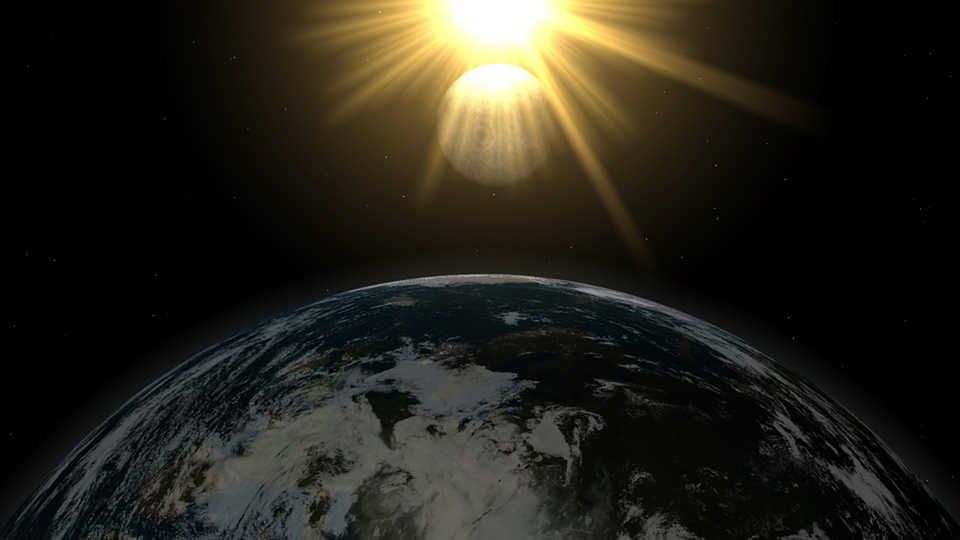By the end of this activity students will be able to:
- use a model to describe why and how a solar eclipse happens.
- describe how the sizes of and distances between objects affects what can be observed.

How much space is truly in space? And how does the distance between things affect the ways that objects in space are perceived?
This activity leads students to explore the concepts of size, distance and scale through using 3-dimensional models to understand these question in regards to the Earth, the Moon, and the Sun. Students begin with thinking about their own internal mental models, then use different sized balls in order to develop an explanation for why solar eclipses happen.
By the end of this activity students will be able to:
Note: This lesson is written assuming the Sun to be a 48” ball. However, it can be done with smaller dimensions by dividing everything in half.
Each group of 4 students will need the following:
Creating different types of eclipses: If you have one group of students finish the activity early, or you have the time, pose some “challenge” questions to your students:
How much space is truly in space? And how does the distance between things affect the ways that objects in space are perceived?
This activity leads students to explore the concepts of size, distance and scale through using 3-dimensional models to understand these question in regards to the Earth, the Moon, and the Sun. Students begin with thinking about their own internal mental models, then use different sized balls in order to develop an explanation for why solar eclipses happen.
Scientists develop and use models in order to explore how systems work. They can help make a concept that is hard to see become visible. The Next Generation Science Standards state that by the end of 5th grade, students should be able to use models to describe and/or predict phenomena. Additionally, the standards also mention that students should be able to “identify the limitations of models.”
Common Misperceptions
Models and illustrations of the Solar System often represent either size or distances in the solar system because it can be difficult to combine them into one model. This can cause the common misperceptions that the objects in the solar system are close together, or that they are all of similar sizes. This activity in combination with the activity “Moons in Comparison”, can help educators address the common misconceptions that are prevalent.
Additionally, for younger students, they may not realize that objects that are farther away look smaller.
Size
To model the distances between bodies in our solar system accurately where the distance between the Sun and Pluto in the model is 350 feet, the Sun would be 1" in diameter and most of the planets would appear no larger than tiny specks. Thus, it is difficult to accurately model both the sizes of the bodies in our solar system and the distances between them in the same model.
For this model, if you strictly convert the Sun-Earth-Moon system dimensions (diameter of objects and distances of objects), the Sun would be the 48 inch ball, and the Earth (0.5 inch ball) and the Moon (0.1 inch ball, size of a grain of rice) would be 1.25 football fields away. Therefore we enlarged the Earth-Moon system so students will be able to have an easier time visualizing the Moon being apparently the same size as the Sun.
Types of solar eclipses:
A total solar eclipse occurs when the Sun and Moon are exactly in line with the Earth and their apparent sizes are equal, allowing the much fainter solar corona to be visible. During any one eclipse, totality occurs at best only in a narrow track on the surface of Earth.
An annular solar eclipse occurs when the Sun and Moon are exactly in line with the Earth, but the apparent size of the Moon is smaller than that of the Sun. Hence the Sun appears as a very bright ring, or annulus, surrounding the dark disk of the Moon.
If you want to connect to algebra (not necessary for the activity):
In astronomy, the apparent sizes of celestial objects are often given in terms of their angular diameter as seen from Earth, rather than their actual sizes. Since these angular diameters are typically small, it is common to present them in arcseconds. An arcsecond (“) is one 3,600th of 1 degree, and 1 radian is 180 degrees/pi, so 1 radian is about 206,265 arcseconds. Therefore, the angular diameter of an object with physical diameter d at a distance D, expressed in arcseconds, is given by (206,265*d)/D arcseconds.
When calculated, the Sun’s angular diameter is between 31’31” and 32’33” depending on where the Earth is in its orbit. The Moon’s angular diameter has a larger range 29’20” to 34’6”. This means at times the Sun and the Moon’s apparent sizes are the same. When both apparent sizes and the objects physically align, places on Earth will observe a total solar eclipse. When the Moon appears to be slightly smaller than the Sun and the objects physically align, leaving the Sun’s visible outer edges, this is called an annular solar eclipse.
moon: A natural object that orbits a larger object.
eclipse: when one celestial body such as a moon or planet moves into the shadow of another celestial body.
solar eclipse: a type of eclipse that occurs when the Moon passes between the Sun and Earth, and the Moon fully or partially blocks the light from the Sun.
Science and Engineering Practices
Disciplinary Core Ideas
Cross-Cutting Concepts
The activity outlined here is just one step toward reaching the Performance Expectations listed below. Additional supporting materials and lessons will be required.
MS-ESS1-2: Develop and use a model to describe the role of gravity in the motions within galaxies and the solar system
MS-ESS1-3: Analyze and interpret data to determine scale properties of objects in the solar system